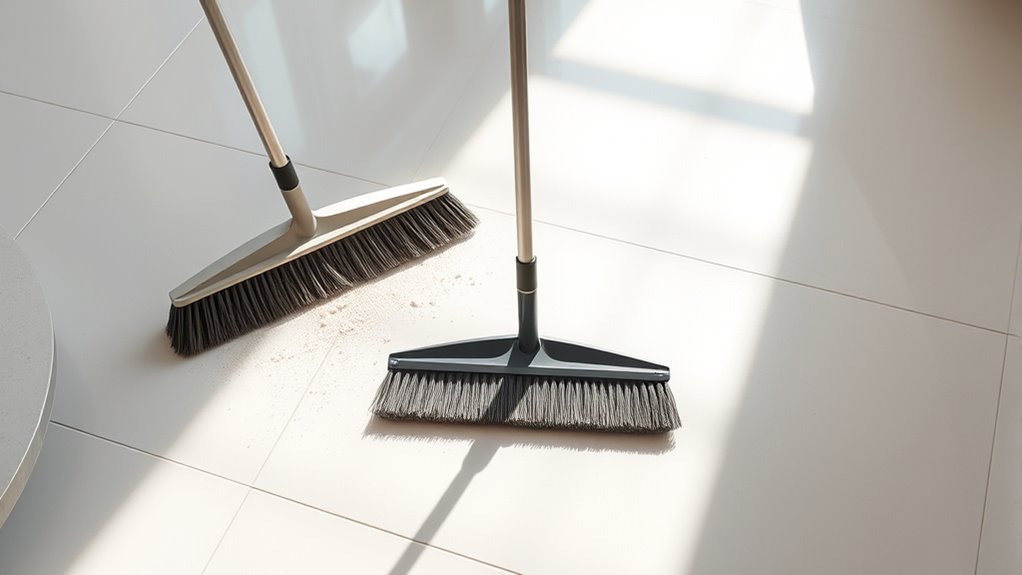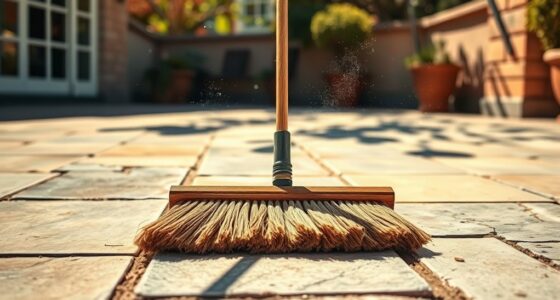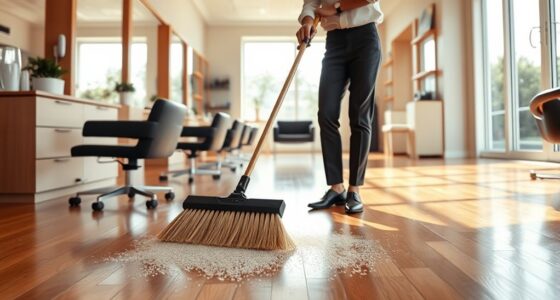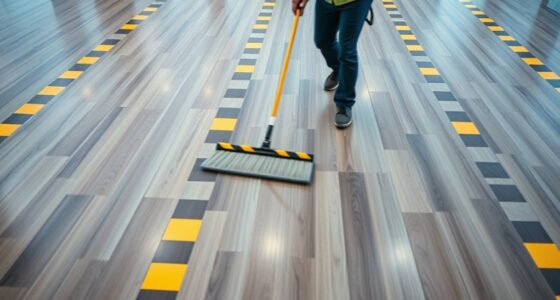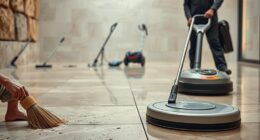To beat fine dust on tile floors, start with a thorough vacuum using a soft brush or upholstery attachment to loosen and lift dust from surface and grout lines. Follow up with a damp mop using a microfiber or well-wrung sponge mop, working in small sections with overlapping strokes. Change the water frequently to prevent redistributing dust. This two-pass plan guarantees your floor is spotless and shiny—keep going to discover more tips for best results.
Key Takeaways
- Vacuum tile floors twice weekly using a soft brush or upholstery attachment to loosen and lift surface dust effectively.
- Use a damp microfiber or sponge mop with a gentle cleaning solution for a thorough second pass, removing residual dust.
- Work in small sections with overlapping, straight strokes to ensure complete coverage and prevent dust redistribution.
- Change mop water frequently during mopping to avoid spreading dust back onto the floor.
- Focus on grout lines and stubborn spots with gentle scrubbing to maintain a shiny, dust-free surface.

Tile floors can quickly accumulate fine dust, making them look dirty even after cleaning. This dust is often invisible to the naked eye but dulls the shine and can cause allergies or respiratory issues if left unaddressed. To keep your floors spotless, you need a strategic plan that tackles dust effectively and efficiently. A two-pass sweeping approach works well, combining the right vacuum frequency with proper mop techniques to remove dust thoroughly.
First, focus on vacuum frequency. Regular vacuuming is essential because fine dust settles quickly into the tiny crevices of tile grout and surface. If you wait too long between vacuum sessions, dust becomes ingrained, making it harder to clean. Ideally, you should vacuum your tile floors at least twice a week, especially in high-traffic areas. Use a vacuum cleaner with a soft brush or upholstery attachment to avoid scratching the tiles. This initial step loosens and lifts surface dust, preventing it from spreading around when you start mopping. The more consistent you are with vacuuming, the less dust will settle in the grout lines and on the surface, reducing the effort needed during mopping.
Next, refine your mop techniques during the second pass. After vacuuming, damp mopping is essential to pick up residual dust and dirt. Use a microfiber mop or a well-wrung sponge mop for the best results. Start by rinsing the mop in warm water with a gentle cleaning solution, then wring it out thoroughly to prevent excess water from pooling on your floor. Work in small sections, moving the mop in straight, overlapping strokes to cover every inch. Be sure to change the water frequently to avoid redistributing the dust you’ve just lifted. Over-wetting the floor can lead to streaks and longer drying times, so aim for a moist, not soaked, mop. For stubborn spots or grout lines where dust tends to settle, switch to a soft brush or use a slightly stronger cleaning solution to scrub gently.
Frequently Asked Questions
What Tools Are Best for Sweeping Fine Dust Effectively?
You should use microfiber mops and cordless vacuums to sweep fine dust effectively. Microfiber mops trap tiny particles better than traditional brooms, making them ideal for delicate dust. Cordless vacuums offer portability and strong suction, allowing you to quickly pick up dust from tiles without hassle. Combining these tools guarantees thorough cleaning, leaving your floors spotless and dust-free with less effort and time.
How Often Should I Perform the Two-Pass Sweeping Plan?
You should perform the two-pass sweeping plan at least twice a week, especially if dust accumulation is high. Regular sweeping helps keep dust from building up, making cleaning easier and floors healthier. Incorporate this into your cleaning schedule tips by adjusting frequency based on dust levels—more often in high-traffic or dusty areas. Consistent sweeping prevents dust from settling deeply, ensuring your tile floors stay clean and free of fine dust.
Can I Use a Regular Broom for Fine Dust Removal?
Using a regular broom for fine dust removal is like trying to sweep water with a squeegee—you might move some dust, but it won’t capture the tiny particles effectively. Opt for a broom with soft bristles designed for dust particle size, and remember to maintain it regularly to keep it effective. Proper broom maintenance guarantees you pick up fine dust efficiently, leaving your tile floors spotless.
Does Wet Mopping Improve Dust Removal After Sweeping?
Wet mopping definitely improves dust removal after sweeping by capturing airborne dust that sweeping may leave behind. Regular cleaning frequency helps keep dust levels low, reducing the amount that becomes airborne. When you wet mop, you’re effectively trapping fine dust particles, preventing them from resettling on your tile floors. This method results in a cleaner surface and healthier indoor air quality, especially if you maintain consistent cleaning routines.
Are There Specific Products to Prevent Dust Buildup on Tiles?
Yes, you can use dust-resistant coatings to help prevent dust buildup on your tiles. These coatings create a barrier that reduces dust adhesion, making cleaning easier. Pair this with air purifiers in your space to improve overall air quality and minimize dust settling. Regular sweeping and mopping also help maintain a clean surface, but these products and devices work together to keep your tiles dust-free for longer periods.
Conclusion
Now that you’ve mastered the two-pass sweeping plan, your tile floors will gleam with cleanliness. But remember, beneath the shine lies the unseen fine dust—silent and persistent. While your efforts reveal a sparkling surface, the dust remains a quiet reminder of what’s often overlooked. Embrace this routine not just for a spotless floor, but to honor the effort it takes to keep your home truly pristine. Cleanliness is a victory, but awareness makes it meaningful.
